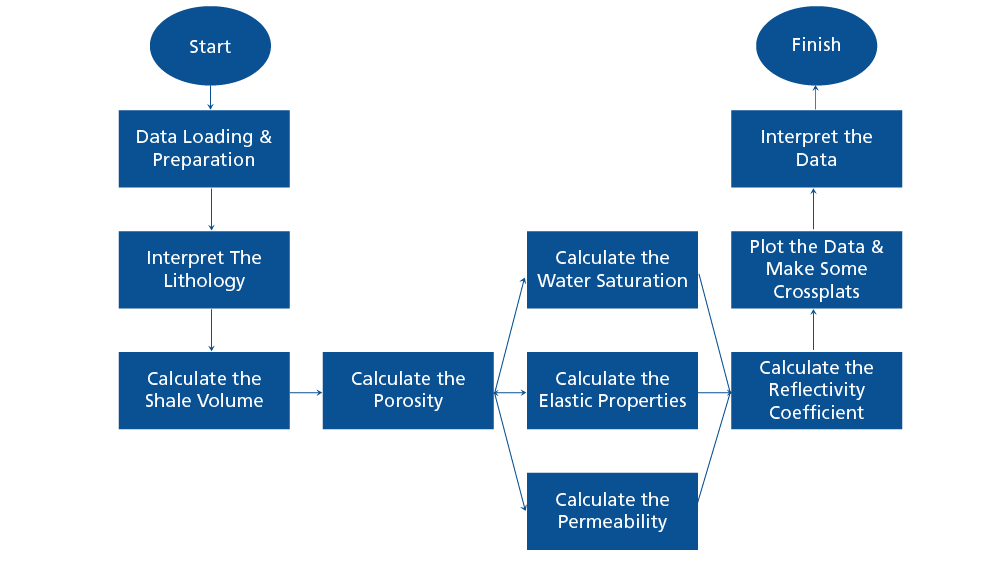AI-ML-based tool for Electro facies classification of well log data
The upstream oil and gas exploration process involves acquiring and interpreting geological and geophysical datasets to locate and extract commercial hydrocarbon volumes. One of the most critical data sets used is the well log. It consists of a detailed set of formation properties measured in terms of geophysical parameters during the drilling of a well. The well log provides physical measurements made by multiple geophysical tools and receivers attached either to the drill bit or using a specialized tool called sonde that is lowered into the borehole. Two methods acquire the subsurface information- wireline logging (log data acquired after drilling) and logging while drilling (log data acquired during drilling).
The well-log data is interpreted using workstations and specialized petro-technical applications to predict and correlate formation properties like lithology, porosity, fluid content, and pressure. The logs mainly used by industry experts for deriving the required information are Gamma Ray (GR), Spontaneous Potential (SP), resistivity, density, neutron, sonic, calliper, image, etc. These logs give different responses against the formation based on the principle it works on. Interpreting a well log response to estimate the subsurface geophysical properties of the borehole can be a massively time-consuming task for Petro physicists.
The interpretation cycle time can be considerably reduced by AI-ML-based tools that can be leveraged for the electrofacies analysis. This blog presents a quick yet comprehensive insight into major workflow steps and their advantages.
AI-ML tool for well-log interpretation
Artificial Intelligence (AI) and Machine Learning (ML) techniques can quickly interpret the log data from drilled wells to predict lithology and formation properties. A good use case for using automated AI-ML techniques is to predict the electro-facies in the region where petroleum exploration is being undertaken. In this case, the results from the key wells are used to train the model predicting the rock type. Whenever any new well is drilled in the known region, the prepared model will give an auto-interpreted first-hand result of the desired lithological types. Based on the predicted lithology, the facies model of the area can be quickly built. These techniques make the task of petrophysical interpretation a lot easier and significantly reduce the time required for interpretation.
The deep domain knowledge of the Petro-physicist can be combined with the latest AI/ ML technology to build a futuristic tool, which can clean and interpret the electrofacies of subsurface formations using a different set of logs. Ideally, the tool can also be integrated with cloud-native data platforms like Open Subsurface Data Universe (OSDU) to deliver world-class results.
Well log interpretation workflow steps
Over the years, significant development has been made in the logging tools and techniques for well log data acquisition and interpretation. The outcome of any interpretation depends on the quality of the original wireline and LWD datasets. However, specific data challenges need to be addressed. In certain boreholes, the physical condition may have degraded to a level beyond the physical measurement limits of the tool. Integrating legacy data acquired using different tools can also be difficult in mature fields. These problems (data outliers) encountered during the data mining and integration phases must be addressed before subsequent data well log data integration and interpretation. Generally, all logs have to be corrected for environmental and borehole geometry effects.
The lithology interpretation is usually carried out based on GR, SP, resistivity, and density logs. Multiple cross-plots of parameters are used to evaluate the petrophysical and rock properties of the formations drilled.
The following workflow steps should be followed as a best practice for all well log data interpretation types, including electro-facies analysis.

Figure 1: Basic steps for well log interpretation
- Data cleaning: This is a primary step wherein the logs are visually inspected, QCed, and manually corrected for various anomalies. Legacy log datasets are especially prone to errors and need a significant data-cleaning process. The clutter from the log data can be removed by:
- NAN values: Missing values in the datasets
- Outliers: Outliers are data points that lie outside the normal/expected statistical distribution of the datasets. They arise mainly due to measurement errors due to sensor malfunction, borehole washout, and unexpected drilling events. A domain-centric analysis is needed to correct the data for the outliers.
- Spikes: Sudden increase of data values beyond the expected range. The extremely unrealistic values must be removed.
Once the bad data and outliers have been identified, they must be removed from the well log data before carrying out any petrophysical analysis. This time-consuming process can be simplified through AI ML automation/semiautomation to a great extent by defining the business rules and corrective processes.
- Data normalization: Well log normalization is used to remove the data inaccuracies arising from different borehole conditions and sensors used (especially for data from different vintages). Once cleaning is done, data normalization through re-scaling and re-calibration is required to bring all the log curves to the same scale to be consistent with other well logs in the field.
- Well log correlation: In this step, logs are correlated across wells in a field based on formation tops and lithologies. Here, well log data and seismic and drilled well information are integrated.
- Prediction of missing logs: Missing log data can be infilled using offset well information based on empirical relationships or ML models.
- Interpretation/Facies Prediction: Facies are a group of rocks with the same lithology. It is one of the most important outputs from the petrophysical interpretation since it shows the subsurface distribution of the various lithologies across the field.
- Interpretation/Geomechanical and petrophysical property prediction: Well log parameters such as bulk density and acoustic slowness can be used to evaluate and predict the stress and rock properties. These geo-mechanical properties are critical in the planning of a well. The parameters assessed from well logs can be cross-checked with the actual measurements in core samples. Well-established equations are used to evaluate petrophysical properties like porosity, permeability, and pore fluid composition from well log data.
AI-ML algorithms in electrofacies classification of well logs
Electrofacies refer to a group or class of well logs that have similar patterns in the multivariate space. They can be used to separate the material properties of rocks and fluids in the region where the log data has been acquired. These data can be validated based on core and other direct samples collected in the well. The identified Electrofacies can be used to inter the lithologic characteristics of an uncovered well.
Artificial intelligence is a technique of data analysis wherein the AI-Models learn from the data, identify the patterns, and makes targeted predictions with minimal human interventions. The main advantages of such an approach are that it is data-driven, does not require prior knowledge of petrophysical interpretation, can self-calibrate based on input datasets, and can work with a large set of data.
Due to recent advances in computational technologies, AI-driven ML algorithms and models have been built to achieve the following business objectives:
- Automatically and quickly evaluate the quality of logs and improve the reservoir imaging capabilities.
- Rapidly carry out data QC, bad data identification, and data correction.
- Execute multi-well workflows integrating many datasets from the target and offset wells.
- Build ML models using lithostratigraphic information from interpreted well logs.
A series of mathematical models that can be leveraged to get an automated answer include various statistical and mathematical tools like Principal Component Analysis (PCA), multivariate analysis, non-parametric regress, classification tree, and techniques based on AI and clustering. These statistical and regressing algorithms can be configured to user scenarios to get an optimal result.
A feed-forward neural network and clustering technique can be used to find out the correct facies. The dimensionality reduction and clustering can be achieved using PCA and K-Mean techniques, respectively. The artificial neural network with the help of the final interpreted litho-log could be used to develop an Artificial Neural Network model. This model will be used to derive the litho-logs at the blind well location and validate them. The litho-log will be derived at all the well locations, and all these datasets at the drilled well locations will be used together to create a regional facies model.
The pre-requisites for a successful electro-facies model are as follows:
- Good conventional well logs.
- Core data (If available)
- Good understanding of rock physics
The automated tool used for electrofacies classification can be integrated with the OSDU data platform to be in sync with the industry-wide trend to adopt a cloud-native standard-based data platform. Such an integration would help the interpreter leverage the extracted metadata and the log data in a single platform for a quick yet comprehensive analysis.
Advantages
Electrofacies classification of well logs is a critical step in predicting lithologies in wells drilled as a part of the exploration program. Automating the process of deriving an electrofacies from already recorded well log based on AI-ML algorithms removes the human bias and makes the process faster and smoother. The electrofacies classification tool can be extended for other reservoir parameter calculations like porosity, permeability, volumetric, and other rock models as per user requirements.
LTIMindtree’s team of techno-domain specialists have created a tool specialized for classifying electrofacies from well data using AI ML automation. To learn about this tool, contact the LTIMindtree team at rakesh.borge@lntinfotech.com or manesh.parmar@lntinfotech.com
Latest Blogs
Core banking platforms like Temenos Transact, FIS® Systematics, Fiserv DNA, Thought Machine,…
We are at a turning point for healthcare. The complexity of healthcare systems, strict regulations,…
Clinical trials evaluate the efficacy and safety of a new drug before it comes into the market.…
Introduction In the upstream oil and gas industry, drilling each well is a high-cost, high-risk…




